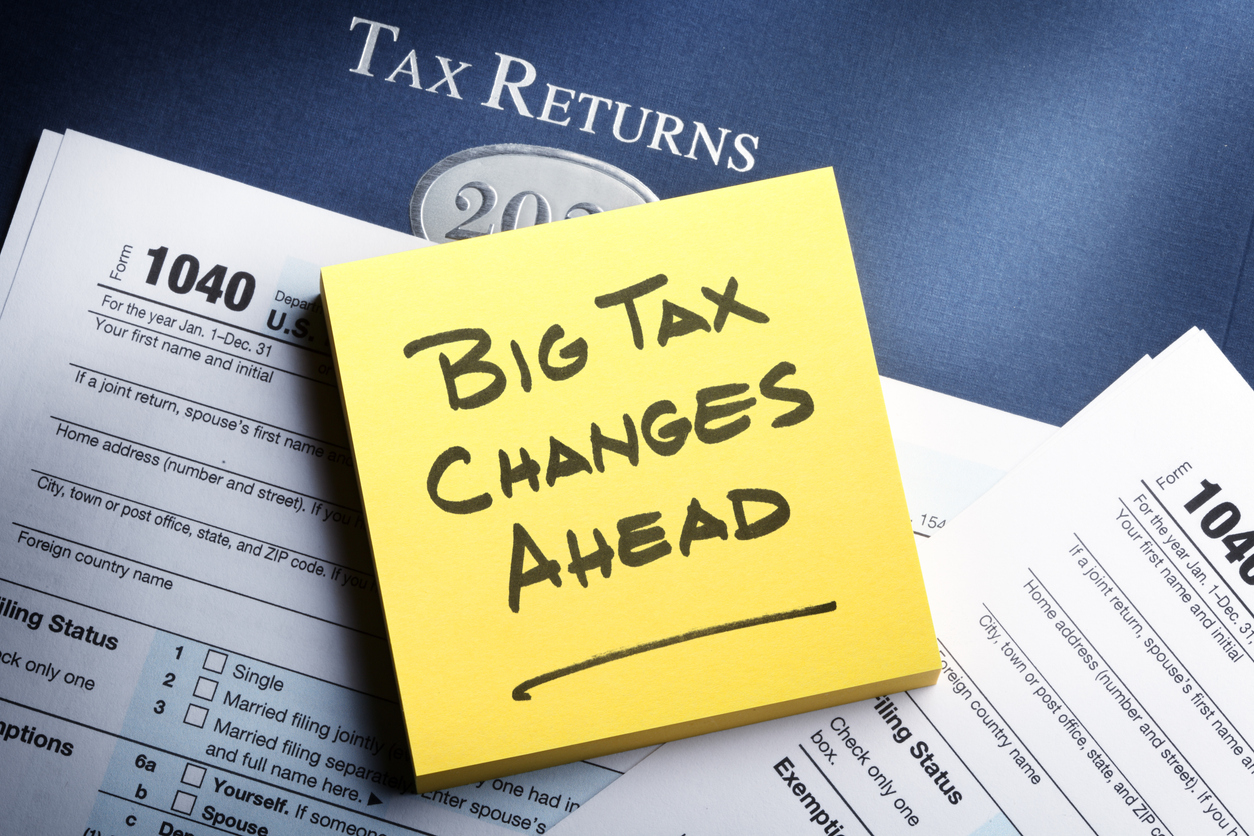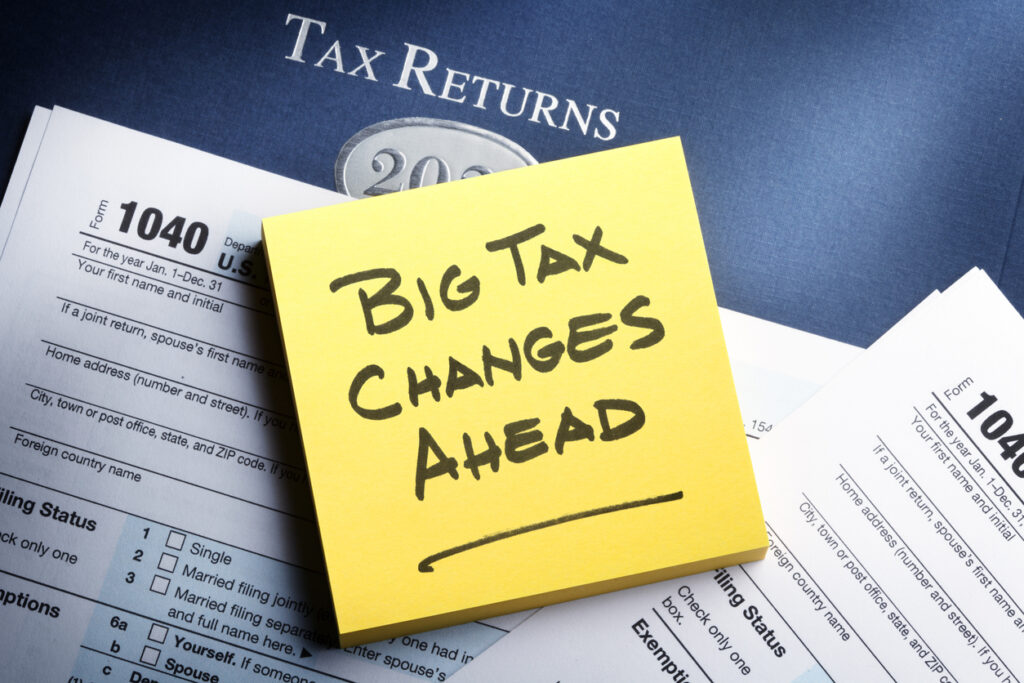One Big Beautiful Bill Act – Part 1


With most of Trump’s tax bill from his first administration, The Tax Cut and Jobs Act (TCJA) of 2017, set to sunset at the end of this year, we knew there had to be some excitement in the world of tax law changes and tax planning coming this year! While the initial suggestions were perhaps a simple extension of the provisions in the TCJA, we ended up with some components of the TCJA made permanent, some expanded, and also brand-new tax provisions.
There are numerous changes that may have financial planning implications for years to come, and we’ll continue to report as we and other professionals around the country digest the bill, the planning opportunities, the potential issues to be aware of, and the actual filing of tax returns with the new laws incorporated. Fortunately, and impressively, the tax planning software we use had the full bill implemented into the system within less than 24 hours from when the bill was signed into law!
Today, we’ll first focus on two big changes with impending deadlines:
-
EV Credit
The federal tax credit for buying a new electric vehicle (up to $7,500 for new EVs, $4,000 for used EVs) will end as of September 30, 2025 (that’s this year – just a couple months from now!).
-
- This tax credit is nonrefundable, which means you can’t get back more on the credit that you paid/owe in taxes. This credit cannot be carried forward to future tax years.
-
- If you have been preparing to buy a new EV or know you need to buy one soon, it may be time to act. A tax credit isn’t the sole reason to buy a new car so there’s no specific action you need to take if you aren’t already in the market or weren’t planning to be anytime soon.
-
Solar Panel Credit
The federal tax credit (Residential Clean Energy Tax Credit) for installing solar panels on your home (currently 30% of the cost of the system), which was initially set to expire at the end of 2032, will now expire December 31, 2025 (that’s also this year – and your solar panels must be fully installed by this date to claim the credit).
-
- Because it can take some time to finalize the contractor you’ll use, confirm the contract, and then actually do the work required to install the panels, if you’re in the process or seriously considering, you need to act fast.
-
- One tax professional we work closely with suggested you could try incorporating a clause in the contract that you receive a roughly 30% discount if the work isn’t completed by 12/31/2025 – worth a try!
-
- This tax credit is also nonrefundable, so you can’t get back more than you paid/owe in taxes, but it can be carried forward to offset taxes in future tax years.
-
- Again, a tax credit isn’t the sole reason to do something so if you aren’t interested in or weren’t ever planning to install solar panels, you don’t need to take any action.
While there will be more detail to come on our upcoming webinar and in future articles here in TheLiveBigWay® Digest, here are some of the other major changes in this bill:
-
Tax Brackets
-
- The income tax brackets from the 2017 TCJA have been made permanent (10%, 12%, 22%, 24%, 32%, 35% and 37%).
-
Deductions
-
- The increased standard deduction from the TCJA has been made permanent and has increased slightly for inflation adjustments for 2025:
- Single or Married Filing Separately — $15,750
- Head of Household — $23,625
- Married Filing Jointly (MFJ) — $31,500
- The increased standard deduction from the TCJA has been made permanent and has increased slightly for inflation adjustments for 2025:
-
- For those in the top 37% marginal tax bracket, the benefit of (tax savings from) itemized deductions will be limited to 35% (the calculation reduces allowable deductions by 2/37ths) starting in 2026.
-
- The State and Local Tax deduction (SALT) has been increased to $40,000 for the 2025 tax year (and this maximum will increase by 1% each year for 2026-2029, then revert to $10,000 in 2030).
- This credit starts to phase out at $500,000 of income for single, head of household, and MFJ filers (the phase out starts at $250,000 for married filing separate (MFS)), and phases out by 30% of the amount of income over $500,000 until it gets the floor of $10,000 at $600,000 of income ($300,000 MFS). You will still get the $10,000 SALT deduction as is currently in place even if your income is above the maximum phaseout level of $600,000 ($300,000 MFS).
- The State and Local Tax deduction (SALT) has been increased to $40,000 for the 2025 tax year (and this maximum will increase by 1% each year for 2026-2029, then revert to $10,000 in 2030).
-
- There are a few new, temporary “below-the-line” deductions (this type of deduction does not reduce AGI, which, as you may note, is used for figuring the income levels for many phaseouts of various credits/deductions) in place for the 2025 – 2028 tax years:
- A $6,000 deduction for seniors age 65+ – this deduction is in addition to the current additional standard deduction for seniors and can be claimed whether you itemize deductions or use the standard deduction.
- It does include an income phaseout starting at $75,000 ($150,000 MFJ) and the deduction(s) is(are) fully phased out at income of $175,000 ($250,000 MFJ).
- A deduction of up to $25,000 for income from tips, which will start to phase out by $100 for every $1,000 of income over $150,000 for single or head of household filers ($300,000 MFJ).
- A deduction of up to $12,500 for single/head of household ($25,000 MFJ) for income from overtime with the same phaseout as the deduction for tip income above.
- A deduction of up to $10,000 on qualifying auto loan interest for new personal car purchases after 12/31/2024 for cars assembled in the U.S. only. Note – if you refinance an existing car loan and do not increase the loan value, the interest can be deducted.
- This deduction phases out between income levels of $100,000 ($200,000 MFJ) and $149,000 ($249,000 MFJ).
- A $6,000 deduction for seniors age 65+ – this deduction is in addition to the current additional standard deduction for seniors and can be claimed whether you itemize deductions or use the standard deduction.
- There are a few new, temporary “below-the-line” deductions (this type of deduction does not reduce AGI, which, as you may note, is used for figuring the income levels for many phaseouts of various credits/deductions) in place for the 2025 – 2028 tax years:
-
- While there have been various limitations on charitable deductions for a long time, there is also a new 0.5% of income (adjusted gross income – AGI) “floor” starting with the 2026 tax year. This means that deductions will only be allowed and show up on your Schedule A to the extent you donate more than 0.5% of your AGI.
-
-
- For those with ongoing charitable contributions, it will likely make sense to explore “bunching” a few years’ worth of giving into this year. And for those of RMD age with ongoing charitable contributions, it will continue to make sense to take advantage of Qualified Charitable Distributions (QCDs) from IRAs. We’ll be reviewing tax returns and projections and reaching out if we think you need to take action.
-
-
Provisions Related to Children
-
- The Child Tax Credit has been permanently increased to $2,200 starting in 2025. This credit phases out by $50 for every $1,000 of income above $200,000 ($400,000 MFJ).
-
- The Child and Dependent Care Credit has had an increase in the percentage of care expenses that will be used to calculate the credit starting in 2026.
-
- The contribution limit for dependent care Flexible Savings Account (FSAs) will increase from $5,000 to $7,500 for plan years starting in 2026.
-
- The list of eligible expenses for 529 withdrawals has been expanded for K-12 withdrawals and for postsecondary credential expenses.
- The amount that may be withdrawn for these K-12 expenses has been increased, too (from $10,000 per year to $20,000 per year starting in 2026).
- The list of eligible expenses for 529 withdrawals has been expanded for K-12 withdrawals and for postsecondary credential expenses.
-
Other Provisions
-
- The higher estate tax exemption has been made permanent and is increased to $15,000,000 for 2026.
-
- The Qualified Business Income (QBI) deduction (up to 20% of QBI) has been made permanent.
-
- There are new investment accounts (like an IRA) called “Trump Accounts” that can be opened and funded for children from birth to 18. Stay tuned for more details on these in the next OBBBA article!
While many of the changes were simply making TCJA provisions permanent, there are a few notable new provisions and plenty of strategic planning opportunities. And more minor changes that we haven’t even listed here yet!
We will continue to digest the bill and the implications and will be reaching out directly if we believe there is action you need to take prior to the end of this year (like considering bunching charitable contributions into 2025). We’ll also share more on our coming webinar and in future posts here.
As always, we’re good people to think with so reach out with any questions you have and we’ll be happy to chat!
